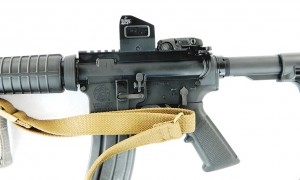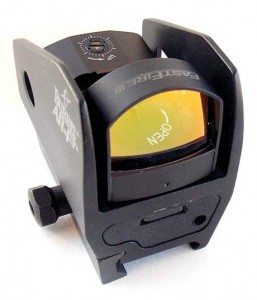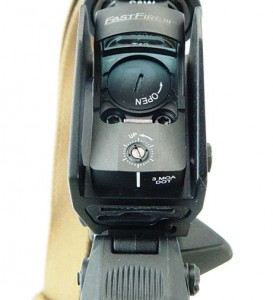by R.K. Campbell | Contributing Editor
Red dot sights are plentiful and the choices may be confusing. Some are cheap products, best suited to .22 caliber rimfire firearms. Others are service grade and often expensive. While quality is never a bad investment, most of us are interested in a durable sight with good features at a fair price. Inexpensive red dots are useful as trainers but the better types are useful for personal defense and hunting. All of us have budgets, some larger than others, and many of us have been burned by a cheap product. “Buy cheap-buy twice” is true.
The Burris FastFire™ 3 is an affordable, useful red dot sight from a respected name. After several months of use I find the FF3 is versatile and useful. No single optic is a go anywhere do anything choice for every rifle but the AR FF3 is useful and versatile. I find the red dot especially well-suited to personal defense, others will find it a good beginning at three gun matches. The sight is a good choice for predators and varmints at moderate range in the Ranch Rifle niche. The AR FF3 features magnification of 1.07x, which offers an excellent field of view. With magnification, the use of both eyes at once, an important advantage in personal defense shooting, is nullified. The strength of the sight is that tunnel vision that often occurs with a long tunnel type sight is eliminated. The intent with a red dot sight is to allow an open field of view while the red dot is superimposed on the target. The AR FF3 red dot covers 4 MOA at 100 yards. It mounts easily on a standard Picatinny rail. The sight window is 21 mm x 15mm. Adjustment range allows good sighting-in to 100 yards, or slightly more. Both elevation and adjustment are generous with the range of degree 190 inches at 100 yards.

The Burris Red Dot takes up little room on the rail of the S&W M&P .223 AR. The author also fitted a blue force sling to the rifle. The combination is good.
In practical terms the sight adds nothing to the weight of the gun at only .9 ounces. The sight is easily mounted and sighted in. Take a close look at the Red Dot and the sight is simple to operate. There is a top cap for the battery. The elevation knob is at top and both elevation and windage are adjustable with a coin. There is a power button for turning the sight on.
Some practice is demanded in order to properly adjust the dot’s brightness. The first setting is the automatic setting. A sensor at the front of the lens senses light from the target and adjusts the red dot so that it is not overpowered by light from the target area. Next, press the power button again and you have the highest power setting. The next setting is a medium brightness followed by the dimmest setting, and the next press of the button turns the sight’s power off. You may quickly change the setting. I think that most of us will choose our ideal middle of the road setting and leave it at that. I find the automatic setting works as designed but I prefer to leave the Red Dot set for the medium setting. A colleague, a fine shot, leaves his Red Dot on maximum at all times. To each his own and the AR FF3 clearly allows a good range of adjustment.
When setting the zero, remember that the dials move the red dot. When setting elevation for up, the red dot actually moves upwards. Also, a rather coarse zero at moderate range of 25 yards or so may not be accurate at 100 yards, so be certain to confirm zero and keep the rifle sighted for the most likely engagement range.
With the red dot sighted on my personal Smith and Wesson Military and Police Sport rifle, I decided to give the sight a good workout. I began with a good supply of HPR Ammunition 55-grain FMJ loads. These have proven accurate, reliable and clean burning—all we could ask for. This is an excellent resource for practice and even rifle matches. These loads are accurate well past 100 yards. I zeroed the rifle for 200 yards, doing so at 25 yards using proven technique. With an AR 15 rifle with 16-inch barrel zeroed for a 200 yard target, the rifle remains versatile for all around use. On the other hand, the rifle zeroed for 15 yards is ridiculously high at 50 to 100 yards and far less useful. 14 inches high at 100 yards is difficult to account for! As an example, if the rifle is sighted for 200 yards then the bullet will strike about 3 inches low at 10 yards. If you have to pull off a hostage rescue shot, then aim for the brow of the head, not the center of the eyes. At 50 yards you are about .3 inch low, about 1.1 inch high at 100 yards, and then dead on again at 200 yard with the high velocity .223 cartridge.
I engaged in a number of fast moving drills at 15 to 25 yards. The Burris red dot allowed excellent speed. Moving to longer range and slow fire, I found that fast hits at 50 yards were no problem when proper attention to the trigger press was part of the equation. After several weeks with the Burris AR FastFire3 sight, I find it meets my criteria for personal defense. For sporting use the sight should be useful for predators to 100 yards or so. Overall, good kit at a fair price.
That price will vary around $300 or less, depending on MOA choice. My 4MOA model was purchased on line for about $250.






